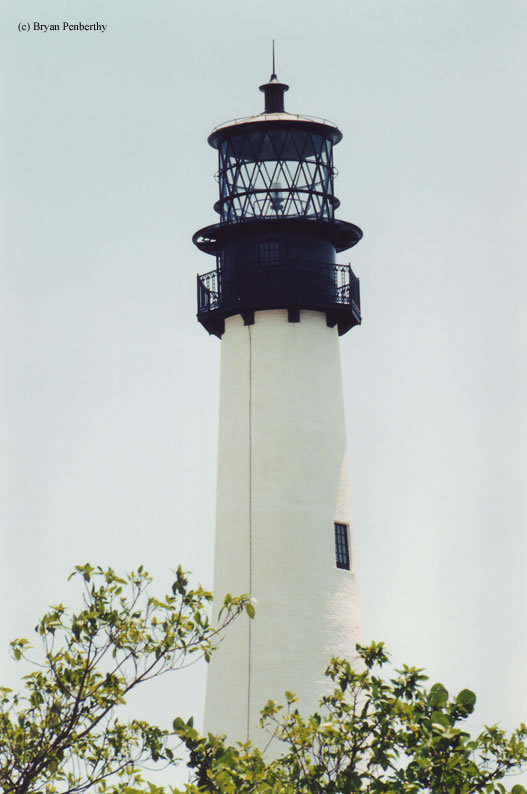Cape Florida Lighthouse
Key Biscayne, Florida - 1845 (1825**)

History of the Cape Florida Lighthouse
Posted/Updated by Bryan Penberthy on 2000-05-29.
One of the first few lighthouses built in the new territory annex of Florida in 1825. The lighthouse was built by a contractor named Samuel Lincoln. It was later found out that had defrauded the Government by giving the tower hollow walls. This had allowed him a great profit margin. There is an interesting story on how this was found out.
In 1835, the tower was under siege. It wasn't by a hurricane or the threat of beach erosion, but rather the Seminole Indians. The event took place during the Second Seminole War. The Indians had attacked what was a small town near the lighthouse. During this attack, the lighthouse keeper's wife and children were left for dead, and the lighthouse keeper William Cooley was having a hard time coping, so he resigned.
This left the assistant keeper, a fellow named John Thompson in charge. He also had the help of a friend named Henry. About four months after the initial attack, the Seminoles decided to attack the lighthouse itself. The two keepers ran into the tower for refuge. A barrage of bullets by the Seminoles had caused the whale oil tanks to leak. Once the Seminoles realized what happened, they set the lighthouse afire. The two men ran to the top of the tower. Once at the top, they realized they were trapped, and the iron floor started burning their feet. If they went to the outer ring of the lighthouse, they would be shot, if they stayed on the inside, they would be burned alive. Henry had tried to jump, but was quickly shot dead. Keeper Thompson was in severe pain. He saw a barrel of gunpowder and rolled it into the fire below him. He figured that this would put him out of his misery, but it didn't. But what it did do, was cause the engulfed staircase to fall to the base of the tower when it exploded. The Seminoles left.
The next day a Navy ship had come to investigate the explosion. They were in awe of the carnage that had taken place. The tower was gutted and dead Indians had lay everywhere. Keeper Thompson was eventually removed from the tower and taken to a military hospital where he later recovered, but not fully. He would be crippled from the ordeal.
It would be nearly ten years before the Government would be able to get to the lighthouse due to Indian troubles, and almost another ten before they would be able repair it. Once it was repaired, it was given a Fresnel lens and an additional thirty feet to make the tower just about 100 feet tall. It would remain in service until 1878 where it was replaced by the off-shore lighthouse at Fowey Rocks. It remained dark for 100 years until the Coast Guard refurbished it and reinstated it in 1978. The lighthouse is the oldest standing structure in Southern Florida.
Directions: On I-95 south, follow signs for the Rickenbacker Causeway. There is a toll to cross this bridge, I believe it was $1.50. You will then follow the Rickenbacker Causeway all the way to the end. Towards the end it will change names to Crandon Blvd. Continue following Crandon Blvd until you reach the Bill Baggs State Park. There is a $5.00 admission charge to enter the park, but It is in this park that you will find the Cape Florida Lighthouse. The lighthouse sits on the Atlantic Ocean side rather than Biscayne Bay. Once in the park, you will be able to see the lighthouse.
Access: Grounds open. Tower open during tours.
View more Cape Florida Lighthouse picturesTower Height: 95.00'
Focal Plane: 100'
Active Aid to Navigation: Yes
*Latitude: 25.66700 N
*Longitude: -80.15600 W
See this lighthouse on Google Maps.
